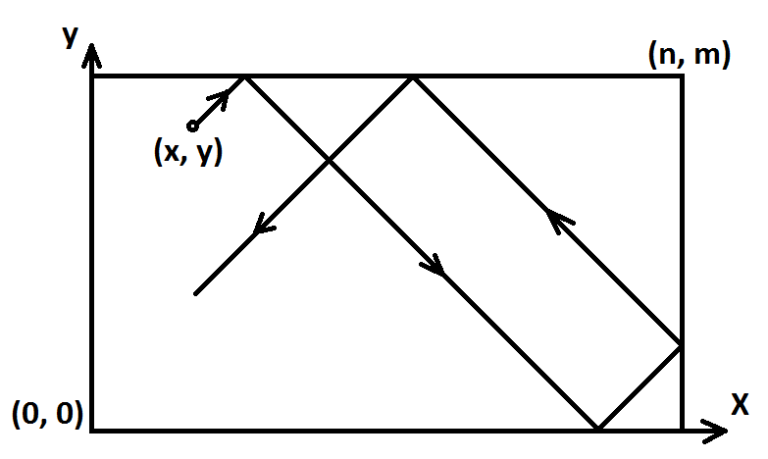Codeforces Codeforces Round #484 (Div. 2) E. Billiard
Codeforces Codeforces Round #484 (Div. 2) E. Billiard
題目連接:
http://codeforces.com/contest/982/problem/E
Description
Consider a billiard table of rectangular size $n \times m$ with four pockets. Let‘s introduce a coordinate system with the origin at the lower left corner (see the picture).

There is one ball at the point $(x, y)$ currently. Max comes to the table and strikes the ball. The ball starts moving along a line that is parallel to one of the axes or that makes a $45^{\circ}$ angle with them. We will assume that:
- the angles between the directions of the ball before and after a collision with a side are equal,
- the ball moves indefinitely long, it only stops when it falls into a pocket,
- the ball can be considered as a point, it falls into a pocket if and only if its coordinates coincide with one of the pockets,
- initially the ball is not in a pocket.
Note that the ball can move along some side, in this case the ball will just fall into the pocket at the end of the side.
Your task is to determine whether the ball will fall into a pocket eventually, and if yes, which of the four pockets it will be.
Sample Input
4 3 2 2 -1 1Sample Output
0 0題意
給定一個球和方向,問能不能在盒子裏停下來
Giving a ball and vector, judge it will stop in the box or not
官方題解以及機器翻譯。。:
如果您在平面上相對於其兩側對稱地反射矩形,則球的新軌跡將更容易。線性軌跡如果是正確的。一個可能的解決方案是
- 如果矢量與軸成90度角,則寫入if-s。
- 否則,轉動場以使影響矢量變為(1,1)。
- 寫出球的直線運動方程: - 1·x + 1·y + C = 0。如果我們用球的初始位置代替,我們可以找到系數C.
- 請註意,在平面的無限平鋪中,可以以(k1·n,k2·m)的形式表示任何孔的坐標。
- 用球的線的方程中的點的坐標代替。丟番圖方程a·k1 + B·k2 = Cis。如果C |可以解決GCD(A,B)。否則,沒有解決方案。
- 在這個丟番圖方程的所有解中,我們對正半軸上的最小值感興趣。
- 通過查找k1,k2可以很容易地得到相應口袋的坐標
- 如果需要,將場轉回。
If you symmetrically reflect a rectangle on the plane relative to its sides, the new trajectory of the ball will be much easier. Linear trajectory if be correct. One possible solution is:
- If the vector is directed at an angle of 90 degrees to the axes, then write the if-s.
- Otherwise, turn the field so that the impact vector becomes (1,?1).
- Write the equation of the direct motion of the ball: ?–?1·x?+?1·y?+?C?=?0. If we substitute the initial position of the ball, we find the coefficient C.
- Note that in the infinite tiling of the plane the coordinates of any holes representable in the form (k1·n,?k2·m).
- Substitute the coordinates of the points in the equation of the line of the ball. The Diophantine equation a·k1?+?B·k2?=?Cis obtained. It is solvable if C?|?gcd(A,?B). Otherwise, there are no solutions.
- Of all the solutions of this Diophantine equation, we are interested in the smallest on the positive half-axis.
- By finding k1,?k2 it is easy to get the coordinates of the corresponding pocket
- Rotate the field back if required.
代碼
#include <bits/stdc++.h>
using namespace std;
long long x, y, xx, yy;
long long vx, vy;
long long fx, fy;
long long c;
long long ex_gcd(long long a, long long b, long long &xa, long long &ya) {
if (!b) {
xa = c;
ya = 0;
return a;
}
long long ret = ex_gcd(b, a % b, xa, ya);
long long temp = xa;
xa = ya;
ya = temp - (a / b) * ya;
return ret;
}
int main() {
ios::sync_with_stdio(false);
cin.tie(nullptr);
cout.tie(nullptr);
cerr.tie(nullptr);
cin >> x >> y >> xx >> yy >> vx >> vy;
if (!vx) {
if (xx == 0 || xx == x) {
if (vy == 1) {
cout << xx << " " << y;
} else {
cout << xx << " " << 0;
}
} else
return 0 * puts("-1");
return 0;
}
if (!vy) {
if (yy == 0 || yy == y) {
if (vx == 1) {
cout << x << " " << yy;
} else {
cout << 0 << " " << yy;
}
} else
return 0 * puts("-1");
return 0;
}
if (vx == -1) fx = 1, xx = x - xx;
if (vy == -1) fy = 1, yy = y - yy;
c = xx - yy;
if (c % __gcd(x, y))
return 0 * puts("-1");
c /= __gcd(x, y);
long long m = y / __gcd(x, y);
long long xxx, yyy;
ex_gcd(x, y, xxx, yyy);
xxx = (xxx % m + m - 1) % m + 1;
yyy = -(yy - xx + x * xxx) / y;
long long ansn = x, ansm = y;
if (xxx % 2 == 0) ansn = x - ansn;
if (yyy % 2 == 0) ansm = y - ansm;
if (fx) ansn = x - ansn;
if (fy) ansm = y - ansm;
cout << ansn << " " << ansm;
}Codeforces Codeforces Round #484 (Div. 2) E. Billiard
